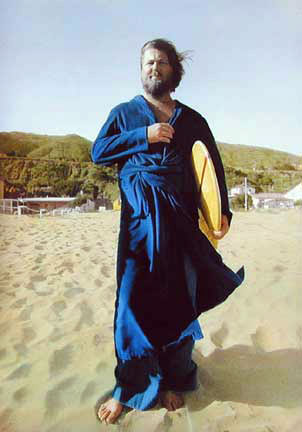 Hard to believe I was almost 30 before I finally listened to Pet Sounds.
Hard to believe I was almost 30 before I finally listened to Pet Sounds.
SUMMERTIME, 1981
In preparation for my first cross-country road trip from the Midwest, to Seattle – where I’ve now made my home since 1985 – I was recording mix tapes to play in the car. I’d already filled several tapes with current bands I was following – XTC, Squeeze, The dB’s, Nick Lowe & Rockpile, Elvis Costello, Split Enz, as well as virtually the entire Beatles oeuvre – but I still had one 2-hour cassette left. My girlfriend suggested that a Beach Boys mix-tape would be perfect for a long summertime road trip.
Frankly, I wasn’t sure. I admit it: I was a rock snob. After the arrival of The Beatles and Bob Dylan, I was one of those who thought he was too far too sophisticated for bands in striped shirts singing about surf and cars and girls with big, um, engines.
Call me shallow.
Okay, sure. I was familiar with The Beach Boys. Generally speaking, I’d always enjoyed hearing their singles on the radio.
And, you know, I’d definitely paid attention when The Beatles claimed that their classic Revolver LP was a response to the gauntlet thrown down by The Beach Boys’ Pet Sounds, which Brian Wilson himself had said was a response to Rubber Soul. However, despite my intrigue by how the Beatles-Brian Wilson  mutual admiration society had spurred my British pop heroes to new artistic heights, it really hadn’t caused me to rush out and buy a slew of Beach Boys records as a result.
mutual admiration society had spurred my British pop heroes to new artistic heights, it really hadn’t caused me to rush out and buy a slew of Beach Boys records as a result.
And, okay, I admit: I really had been knocked out by “Good Vibrations,” a record that’d vied for the honor of most groundbreaking single of 1966, a year full of artistically achieving singles. However, no other post-“Good Vibrations” Beach Boys single came close to the high bar it had established. And, in any event, from what I’d heard, Brian Wilson had become a mental/emotional basketcase, and his output seemed so sporadic and erratic that I just couldn’t be bothered to wade through an entire Beach Boys album to search for a handful of gems among the larger fragments and cast-offs from the failed Smile project that had been planned as a litmus test of Brian Wilson’s so-called genius.
All this was in the back of my mind when my girlfriend requested a Beach Boys mix-tape. In the end, I acquiesced to her request. But I gotta tell ya – the proposition of a 2,000-mile trip by car, with its hours and hours of listening to the same tapes over and over – particularly a 2-hour tape half-filled with most of The Beach Boys’ 1960’s hits and another full hour of what were, for me, mostly unfamiliar selections from a variety of their albums, including the majority of Pet Sounds – well, it seemed a bit daunting.
But over the course of those 2,000 miles and the hours and hours of repeated listening, I found myself hearing The Beach Boys in ways I never had in the previous 20 years of hearing their songs played on the radio. So, maybe it’s not surprising that I underwent a total reassessment of The Beach Boys, starting with the well-known hit songs.
2,000 MILES OF THE BEACH BOYS
One of the first things I noticed was that from the very start of his career, Brian Wilson characterized himself as someone to be reckoned with. Only a mere teenager, Brian was penning songs for his band at a time when virtually all rock bands depended on outside writers for their material, and that was still a year or so before The Beatles made self-written material de rigueur for all subsequent rock groups. And, yeah, the first records – “Surfin’” and “Surfin’ Safari” – were basically exercises in combining doo-wop harmonies with fairly simple 3-chord rockabilly melodies, but no one else had proposed such a combination before that time, and teenager Brian showed himself a master at both. And, then, only a few months later, he had the temerity to add a refrain of his own to the already-classic “Sweet Little Sixteen,” rewrite the lyrics, and turn it into “Surfin’ USA.” Talk about balls – I mean, if you’re gonna steal a cup from someone’s lemonade stand, you’d best do it to the kid no one likes, not the neighborhood hotshot, not Chuck Berry! But Brian did, and “Surfin’ USA” is arguably superior to “Sweet Little Sixteen” because of Brian’s tinkering.
And this was followed in short order by “Surfer Girl,” a striking piece of songwriting in which Wilson took a then-standard 4-chord rock progression, filled out the chords with a bunch of extra notes, and sang it with Four Freshmen-inspired close harmonies. In those simpler days of rock, the beautiful and romantic density of the harmonies, combined with subtle variations in the chord pattern was stunning work, particularly considering that Brian was not yet 20.
 Young though Brian was, then there was also “When I Grow Up to Be a Man,” a song with remarkably mature and foresighted lyrical content, particularly for the early ‘60s – a full decade before introspection became cool among the singer-songwriter set. And, musically speaking, even Brian’s songs were always melodically inventive. For example, even a throwaway hit like “Dance, Dance, Dance” featured an incredibly sophisticated changing of keys between the song’s first two lines.
Young though Brian was, then there was also “When I Grow Up to Be a Man,” a song with remarkably mature and foresighted lyrical content, particularly for the early ‘60s – a full decade before introspection became cool among the singer-songwriter set. And, musically speaking, even Brian’s songs were always melodically inventive. For example, even a throwaway hit like “Dance, Dance, Dance” featured an incredibly sophisticated changing of keys between the song’s first two lines.
And as I crossed the plains of Western Kansas and Eastern Colorado, almost against my will, I’d found myself captivated by those early Beach Boys songs – songs that I’d dismissed years before.
And that was just the start.
Steering my car upwards into the Rockies, the mix-tape continuing another repetition, I also started noticing Brian Wilson’s growing mastery as a producer. Unlike his mentor, Phil Spector, Brian’s recordings weren’t characterized by the sonic bombast of 20-30 musicians in the studio. Instead, Brian employed a standard rhythm section which he supplemented with a small number of oddly matched musical instruments – bass harmonica, marimbas, echoey bongos, a couple horns and strings. It was a sophisticated instrumental palette, and Brian used it to create subtle, nuanced, near-orchestral arrangements that allowed each instrument to have its voice heard at different times throughout a recording instead of getting lost in a Spectoresque wall of sound.
This came to the forefront most strikingly in “California Girls,” a song that gave an early signal of what Brian Wilson later came to call his “pocket symphonies.” The record’s long introduction (nearly 20 seconds!) was comprised of a lush instrumental section that had virtually nothing to do with the remaining 2 minutes of the song’s more traditional rock beat. And despite the fact that the song was one of Brian’s most sophisticated melodic and harmonic to date, it featured an irresistibly catchy refrain – “I wish they all could be California girls.” It was a damn gutsy calculation on Brian’s part – hoping that a teenage audience would sit still long enough for that long orchestral introduction before getting their rock ‘n’ roll fix. But it worked, and “California Girls” was a huge hit.
By the time I was headed north into Big Sky Country, I’d come to a renewed appreciation for those broad, sweeping hooks and radio-friendly refrains that had made Beach Boys records so beloved by millions of teenagers in the 1960’s. And, then, coming after my notice of the subtle arrangement touches of “California Girls,” it was in the last 1,000 miles of my trip, as I headed west across Wyoming and Montana, that I was finally prepared for Side Two of my Beach Boys mix-tape, a side filled with less familiar songs full of nuance and longing. Gone were the celebrations about tanned bodies and cruising the boulevard. These were songs from Pet Sounds.
Of course, I was familiar with the album’s singles – “Wouldn’t It Be Nice” and “Sloop John B,” both of which had gotten lots of radio play. “Caroline, No” also had received radio play, but because it was so different from previous Beach Boys hits, the record was credited to Brian Wilson rather than to the band. But it’s the sadness of “Caroline, No” (a sadness only heretofore alluded to by “In My Room,” a rich young pop star’s cry for help written nearly two years before John Lennon revealed a similar vulnerability in “Help!”) that provided the personality of Pet Sounds’ songs, with the album’s lyricist, Tony Asher, perfectly capturing Brian Wilson’s feelings of vulnerability, alienation, and searching for meaning.
 And while Brian Wilson’s supreme melodicism was still present on Pet Sounds, it was more sophisticated now, the interweaving vocal harmonies even more nuanced , the instrumental accompaniment as complex as the vocals. And unlike the songs celebrating Southern California teenage hedonism – which were fun, to be certain – I found myself touched deeply by songs like “I Just Wasn’t Made for These Times” and “I Know There’s An Answer” – songs that were far more than bumper sticker slogans, songs that spoke to my own feeling of existing outside my circle of friends and family and yearning for something that would satisfy a desire for truth.
And while Brian Wilson’s supreme melodicism was still present on Pet Sounds, it was more sophisticated now, the interweaving vocal harmonies even more nuanced , the instrumental accompaniment as complex as the vocals. And unlike the songs celebrating Southern California teenage hedonism – which were fun, to be certain – I found myself touched deeply by songs like “I Just Wasn’t Made for These Times” and “I Know There’s An Answer” – songs that were far more than bumper sticker slogans, songs that spoke to my own feeling of existing outside my circle of friends and family and yearning for something that would satisfy a desire for truth.
But it was a duet of songs that sealed my fate forever as a late convert to Pet Sounds. Though “Our Prayer” was an outtake from the failed Smile sessions, for some reason – probably out of an effort to be thematically cute – I’d tacked it onto my Beach Boys mix-tape as a quasi-introduction to “God Only Knows.” The short a cappella prayer was almost Bach-like in its structure even while incorporating some unquestionably un-classical pop density in its chord construction. Followed by “God Only Knows,” with its aching melody and sentiments and the the polyphonic harmonies that comprise nearly the last third of the song, at last, I realized why Paul McCartney had called “God Only Knows” the most beautifully written song of the rock era. And played back-to-back, “Our Prayer” and “God Only Knows” served as love songs to both the divine and the human.
And in a handful of songs from Pet Sounds, Brian Wilson had somehow made loneliness and alienation, and human passion and yearning for the divine just as beautiful as he’d earlier made sun and surf. Not surprisingly, the final sounds of the album are the sounds of a favorite pet chasing after the lonely whistle of a train as it speeds by into the night, heading to God knows where . . .
Thus, it was, as I neared the end of my 2000-mile trip crossing plain and mountain and drawing near to Puget Sound, that it finally dawned on me – 15 years after the fact – how logical a progression it had been from Pet Sounds to “Good Vibrations.” For several years Brian Wilson had been introducing audiences to his more challenging ideas in digestible bite-size pieces before springing “Good Vibrations” on them. On the other side of the pond, it was similar to what The Beatles also had been doing with their fans, gradually increasing the vocabulary of rock music with the release of each more and more sophisticated record. The big difference, however, was that Brian Wilson didn’t have a George Martin providing direction. He was his own George Martin!
 And as I came down from the Cascades and drew near Seattle, I found myself embracing “Good Vibrations” anew. It’s a song that is so ubiquitous now, it’s difficult to conceive of a time when it did not exist. But when “Good Vibrations” first hit the airwaves – the AM radio airwaves, mind you – it sounded like nothing else on the radio. In fact, it was strange that such a record became a huge Top Forty hit at all. It aggressively avoided pop music’s standard verse-chorus-verse-chorus structure, employing instead a symphonic approach of introducing and developing recurring themes and constantly changing instrumental textures and rhythms – pretty heady stuff for a 3 minute pop record! And the song’s strange melodicism was as disconcerting as it was catchy. I mean, there was this Theremin thingy straight out of a 1940’s horror movie, which kept haunting what were otherwise supposed to be good vibrations. And even that phrase, not yet part of the pop culture vernacular in 1966 – good vibrations! – it seemed mystical and, possibly suggested something that had to do with altering the mind and emotions. And even in that year that’d already featured such breathtaking singles as “Walk Away, Renee” and the double-sided monster, “Strawberry Fields Forever” / “Penny Lane,” “Good Vibrations” was easily among the most ambitious 3½ minutes of pop music of the rock era – it was, indeed, a pocket symphony.
And as I came down from the Cascades and drew near Seattle, I found myself embracing “Good Vibrations” anew. It’s a song that is so ubiquitous now, it’s difficult to conceive of a time when it did not exist. But when “Good Vibrations” first hit the airwaves – the AM radio airwaves, mind you – it sounded like nothing else on the radio. In fact, it was strange that such a record became a huge Top Forty hit at all. It aggressively avoided pop music’s standard verse-chorus-verse-chorus structure, employing instead a symphonic approach of introducing and developing recurring themes and constantly changing instrumental textures and rhythms – pretty heady stuff for a 3 minute pop record! And the song’s strange melodicism was as disconcerting as it was catchy. I mean, there was this Theremin thingy straight out of a 1940’s horror movie, which kept haunting what were otherwise supposed to be good vibrations. And even that phrase, not yet part of the pop culture vernacular in 1966 – good vibrations! – it seemed mystical and, possibly suggested something that had to do with altering the mind and emotions. And even in that year that’d already featured such breathtaking singles as “Walk Away, Renee” and the double-sided monster, “Strawberry Fields Forever” / “Penny Lane,” “Good Vibrations” was easily among the most ambitious 3½ minutes of pop music of the rock era – it was, indeed, a pocket symphony.
To be sure, my Beach Boys mix-tape featured a good half-hour of wonderful songs that followed “Good Vibrations” and the material from Pet Sounds, songs that gave evidence of Brian Wilson’s genius, even after his Smile-era breakdown – the lyrically deft “Heroes & Villains” featured some transcendent vocal moments; and “Do It Again,” “Darlin’,” and “I Can Hear Music” all recaptured the exuberance of Brian’s earlier sun-and-surf singles, albeit while tinged with a certain regret; “Friends” had a wily waltz time that was carried forward by, of all things, a bass harmonica; and emotionally dense and melodically rich songs like “Feel Flows,” “’Til I Die,” and “Surf’s Up” served as teasers of what Smile might have been.
But by the time I was hearing those songs, I’d already been converted and baptized as a new adherent in the Church of Wilson. Sure, I knew the founding saint was flawed, his output erratic, his vision sometimes impaired. But to correct my earlier assessment – it had, indeed, been worth the time it took to wade through some of the floating detritus to find the gems and shells that washed ashore.
Brother, have you been saved?
– Rich Horton
Also from Rich:
OUT-SPECTORING SPECTOR – Richie’s Reprisal: Thoughts from the Pallid Pilgrim, by Rich Horton



